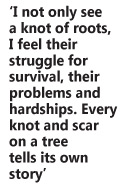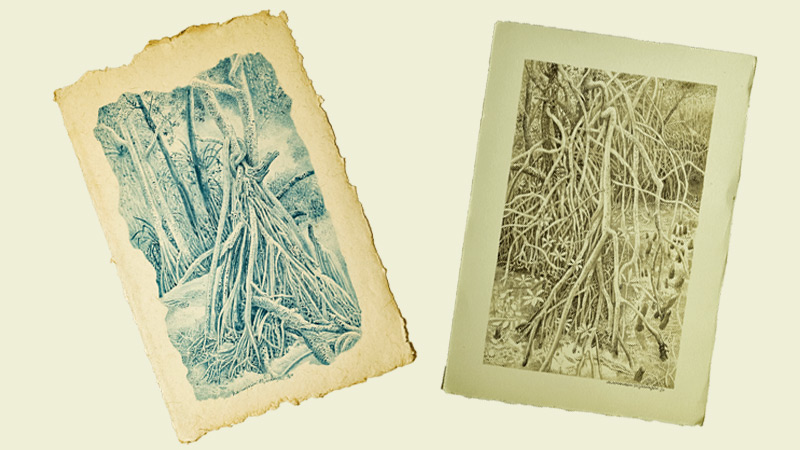With Beneath the Canopy, Karunasiri Wijesinghe continues his 30-year endeavour to represent an aesthetic and spiritual exploration of Sri Lanka’s natural environment.
In the works on view, the artist brings our focus to aerial roots in his portraiture of trees – from the prop roots of Banyan trees in the Viharamahadevi Park to the Pandanus forests of Bentota.
 The meditatively laid strokes highlight salient features such as cross hatching on tentacle-like roots, as well as inconspicuous moments, such as the flutter of leaves in the wind.
The meditatively laid strokes highlight salient features such as cross hatching on tentacle-like roots, as well as inconspicuous moments, such as the flutter of leaves in the wind.
While they appear to be photographic in the detail, Wijesinghe’s works are not only documentary. They are deeply emotive and immortalising, like preserving a loved one’s features and mannerisms.
Inner characteristics
“I don’t draw a landscape as the eye sees it. I draw what speaks to me. It can be a tree, a branch or a network of complex roots. Sometimes it is just part of a tree. I try to bring out its individuality by drawing only that section, devoid of all the complexities around it. I try to bring out the inner characteristic of a particular tree or root, not only the outer appearance. The interconnectedness between trees and shrubs, root systems, the attraction it has to me and the message that they give to me is what I try to convey through my art. The trees speak to me.
“I not only see a knot of roots, I feel their struggle for survival, their problems and hardships. Every knot and scar on a tree tells its own story,” he said.

The artist has travelled across the tropical forest ecology of Sri Lanka since his early 20s. From spending months in the Sinharaja forest in the ‘90s, to now conducting weekly sketching classes in the lush urban garden of Viharamahadevi Park. Wijesinghe is most comfortable in the presence of other tree folk. It is their presence that he acknowledges first, even when he is surrounded by many people.
Building great depth with free, focused strokes while listening to the cool jazz tunes of Chet Baker, Stan Getz, and Dave Brubeck, Wijesinghe says “The intricate network of blood vessels and nerves in the human body is like the root system that binds man with nature. Literature, music, art, sculpture — all forms of art take us back into nature.” Also on view are incomplete sketches, works in progress, and photographs from his extensive stay in the Sinharaja forest.
Research
We see a slow building of the works, starting with pencilled outerform, building depth with hatching and creation of scenery through watercolours. Sometimes he likes to get to know the tree in further detail. His research of trees delves into various facets, like the roots, the flowers, the bark and the scientific names of plants, in English, Sinhala and Tamil.
Karunasiri Wijesinghe (b. 1957, Makadura, Sri Lanka) graduated with a Bachelor of Fine Arts from the Institute of Aesthetic Studies, University of Kelaniya in 1982.
He has taught as Visiting Lecturer at the Vibhavi Academy of Fine Arts (VAFA), Colombo and the University of the Visual and Performing Arts, Colombo. He lives and works in Colombo.







